Overview
- Motivation
- The SINS/zC-SINF and KMOS3D Surveys with VLT/SINFONI+KMOS
- Synergies with PHIBSS/PHIBSS2, HST, HERSCHEL/PEP, and LBT/LUCI
- Galaxy Kinematics and Structure at High Redshift
- Properties and Evolution of High-Redshift Disks
- Powerful Outflows and Star Formation Quenching
- Nebular Gas Excitation and Metallicity
Motivation
The z ~ 1–3 universe, at look-back times of ~ 8 to 11 billion years, is now known to represent a critical epoch in the mass assembly of galaxies. During this era, both the cosmic star formation rate and the luminous quasar space density are at their peak. The assembly of galaxies is correspondingly rapid, with the total stellar mass density in galaxies increasing from ~15% to ~ 50 to 75% its current value between z ~ 3 and z ~ 1. The multitude of multiwavelength photometric surveys and large optical spectroscopic campaigns carried out over the past decade have set the stage for detailed spatially resolved studies of individual galaxies. Such studies are essential to pin down the actual processes that drive early galaxy evolution and to address key questions such as: What is the relative importance of mergers vs. smooth infall in the accretion of mass? What is the connection between bulge and disk formation? What is the interplay between angular momentum, dissipation, and feedback processes? Is the star formation at high redshift mostly driven by major mergers between galaxies of comparable mass, as in present-day galaxies with similarly high star formation rates?
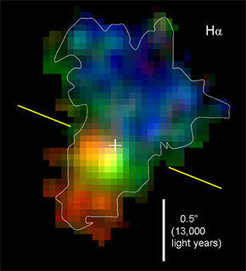
Detailed information on the dynamics, morphologies, and physical properties of distant massive star-forming galaxies (SFGs) at lookback times of 8 to 11 billion years (cosmological redshifts z ~ 1–3), when a major fraction of the mass in stars seen in present-day galaxies is believed to have been put in place. Observations at near-infrared (1–2.5 μm) wavelengths are well-suited to study galaxies at these epochs because many key diagnostic spectral features in the rest-frame optical spectrum of galaxies are redshifted in the near-infrared bands. This includes important emission lines from ionized gas tracing the sites of intense star formation activity or shock-excited material (such as the hydrogen Balmer recombination lines of Hα and Hβ, and the forbidden lines from atomic fine-structure transitions of [NII], [OIII], [OII], [SII]). At rest-optical wavelengths, the continuum light traces the stars that dominate the stellar mass more closely, as it is less affected by dust obscuration and outshining by young luminous stars. Spatially and spectrally resolved information of such key spectral diagnostics have become routinely accessible at high redshift, notably with sensitive near-IR integral field spectrographs mounted on 8 to 10 m ground-based telescopes, such as SINFONI, KMOS and soon ERIS at the ESO Very Large Telescope (VLT).
THE SINS/zC-SINF and KMOS3D Surveys with VLT/SINFONI+KMOS
SINS/zC-SINF was the first and largest survey of spatially resolved ionized gas kinematics, star formation, and physical properties at z ~ 2, carried out with the near-IR single integral field unit (IFU) spectrometer SINFONI at the VLT. The survey used 60 nights of MPE IR/Submm Group Guaranteed Time Observations (GTO) for SPIFFI and PARSEC (the MPE-built spectrometer in SINFONI and the laser for the VLT Laser Guide Star Facility) and 50 nights via several Open Time Programs, including a Large Program in collaboration with the zCOSMOS team. The observations focused on Hα+[NII]+[SII] emission of 110 z ~ 1–3 main-sequence SFGs, all in seeing-limited mode (4 to 5 kiloparsecs resolution), and with adaptive optics (AO) for a sharper view of 35 of the targets (1 to 2 kiloparsecs resolution). The deep SINFONI+AO data were complemented with sensitive ~ 1.5 kiloparsecs resolution mapping of the stellar component using HST NICMOS and WFC3 near-IR imaging.
Taking advantage of the advent of the efficient near-IR 24-IFU KMOS instrument, built by a consortium involving MPE, we conducted the KMOS3D survey, an ambitious and highly successful 75-night GTO program led by the MPE IR/Submm and OPINAS Groups, with USM participation. KMOS3D has mapped the Hα+[NII]+[SII] emission of 740 mass-selected galaxies at z ~ 0.6–2.7, providing the essential extension of our SINFONI studies to larger, homogeneous, and more complete samples. The survey was carried out in well-studied extragalactic fields with extensive multi-wavelength data, including the far-IR Herschel PEP survey led by our group and high-resolution optical/near-IR grism and imaging data from the 3D-HST and CANDELS HST Treasury programs. KMOS3D was designed to provide an unbiased census from deep integrations (~ 5 to 25 hours) of the same spectral diagnostics resolved on seeing-limited scales of 4 to 5 kiloparsecs, over a wide range of galaxy parameters and five billion years of cosmic time. The strategy uniquely enabled faint line emission mapping in individual objects and pushed IFU studies into new regimes, such as lower-mass main-sequence SFGs, and high-mass submain-sequence galaxies in the process of quenching. Altogether, KMOS3D and SINS/zC-SINF span two orders of magnitude in stellar mass (log[M⁎/M☉] ~ 9.5–11.5) and three orders of magnitude in star formation rate (SFR) relative to the main sequence (SFR/SFRMS ~ 0.01–10). Importantly, the KMOS3D targets were drawn from the mass-selected 3D-HST galaxy population with redshifts based on their near-IR HST grism spectra (relying not only on emission line detection but also stellar continuum features), significantly reducing the biases toward the bluest and most intensely SFGs inherent to optical spectroscopic surveys. Our KMOS3D survey has now probed also the redder – more dust-obscured and/or more evolved – part of the z ~ 1–3 galaxy population.
Synergies with PHIBSS/PHIBSS2, HST, Herschel/PEP, and LBT/LUCI
Our detailed in situ studies with KMOS and SINFONI are highly synergetic, with several programs led by our MPE IR/Submm Group using various facilities from optical to millimeter wavelengths. These programs include notably PHIBSS/PHIBSS2 at the IRAM millimeter facility. PHIBSS was a Large Program with NOEMA/PdBI of > 50 z ~ 1–2.5 galaxies carried out from 2009 to 2012. It was substantially expanded with PHIBSS2, a four-year Legacy Program with NOEMA of > 130 z ~ 0.5–3 galaxies started in 2013. PHIBSS/PHIBSS2 cover the massive main-sequence star-forming population over a comparable redshift range as KMOS3D and SINS/zC-SINF, and were largely conducted in the 3D-HST/CANDELS fields accessible from IRAM, thus also benefitting from extensive multiwavelength ancillary data. By targeting normal SFGs at 0.5 < z < 3, rather than rare starbursting "outliers," PHIBSS/PHIBSS2 bridge the gap between conventional molecular gas studies and optical-to-infrared deep look-back surveys. PHIBSS/PHIBSS2 are also providing the first glimpse of the kinematics of the cold, star-forming molecular component of the ISM, which can then be compared with the ionized gas kinematics derived from the above near-IR surveys.
In addition, our detailed characterization of galaxy morphologies from HST ACS optical and WFC3 near-IR imaging in the 3D-HST/CANDELS survey fields have provided key complementary information on stellar structure and populations, strengthening and expanding our main results obtained from the gas components of galaxies. Our results from the Herschel PEP survey, also covering the 3D-HST/CANDELS fields, yielded far-IR calorimetric measurements of star formation activity, unobscured by dust and little affected by AGN activity, of unprecedented samples to z ~ 3. Using the near-IR multiobject spectroscopic mode of LUCI (built in part by MPE) at the Large Binocular Telescope (LBT), we supplement our samples with emission line measurements with z ~ 1–2 SFGs (with now > 100 in hands), including PHIBSS/PHIBSS2 targets inaccessible from the VLT.
Galaxy Kinematics and Structure at High Redshift
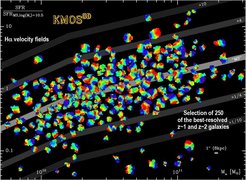
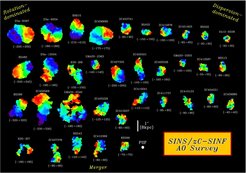
Our comprehensive KMOS3D survey has robustly confirmed the earlier results from SINS/zC-SINF on the kinematics and structure of high-z SFGs. The dynamical support of at least 70% of all z ~ 1–3 massive SFGs is dominated by ordered disk rotation, unlike what would be expected in the case of frequent (major) merging. Interacting/merging systems and more compact, velocity-dispersion-dominated objects constitute a minority population among massive SFGs (Shapiro et al. 2008; Förster Schreiber et al. 2009; Mancini et al. 2011; Newman et al. 2013; Wisnioski et al. 2015). These results are illustrated with the overview of the Hα velocity fields of 250 z ~ 1 and z ~ 2 galaxies from KMOS3D at 4 to 5 kiloparsecs (top right figure), and those obtained at ~ 1.5 kiloparsecs resolution for the 35 SINS/zC-SINF galaxies observed with SINFONI and AO (middle left figure). The rotation velocity vrot scales roughly linearly with galaxy size, consistent with centrifugally supported baryonic disks of constant angular momentum parameter within virialized dark matter halos. Exploiting the high data quality and large sample increase from KMOS3D, we derived the distributions of angular momentum and baryon content of massive log(M⁎/M☉) ≳ 10 SFGs at z ~ 1−3 (Burkert et al. 2016; Wuyts et al. 2016). The inferred halo scale angular momentum distribution of the galaxies is consistent with the theoretical prediction for their dark matter halos in terms of mean spin parameter 〈λ〉 ~ 0.037 and dispersion σ(log λ) ~ 0.2. The data support the long-standing assumption that, on average and up to high redshift, the specific angular momentum of disks reflects that of their dark matter halos (jd = jDM), implying conservation of the net angular momentum of baryons as they settle from the cosmic web and halo onto the central ~ 10 kiloparsec-scale baryonic disks. Our analyses further showed that high-z disks are strongly baryon-dominated, with average baryon-to-total mass fractions ~ 60% within their half-light radii , and average baryon to dark matter mass ratio ~ 5% within their dark halo virial radius – or about 30% of the cosmologically available baryons.
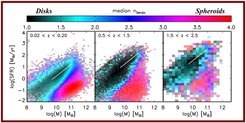
The prevalence of disks among distant SFGs was further strengthened by our study of rest-UV/optical morphologies of large mass-selected samples out to z ~ 2.5: the tight locus defined by the vast majority of SFGs in M∗ vs. SFR is dominated by disk-like systems while rarer "outliers" above and below this "main sequence" show more compact and cuspier morphologies (bottom right figure; Wuyts et al. 2011). This result showed most convincingly that a correlation between galaxy structure and stellar populations, i.e., a Hubble sequence, was already in place just about 3 Gyr after the Big Bang. Unsurprisingly, the rest-optical morphologies of the SINS/zC-SINF AO galaxies also show a majority of disk-like profiles (Förster Schreiber et al. 2011a; Tacchella et al. 2015a). Our resolved measurements of the kinematics and structure of high-redshift galaxies provided key evidence that smoother accretion and internal dynamical processes play a dominant role in growing galaxies, rather than violent major mergers that had been favored for some time. Theoretical support for these findings was provided by our analysis of halo merger fractions and mass accretion rates based on the Millenium Simulation (Genel et al. 2008).
Properties and Evolution of High-Redshift Disks
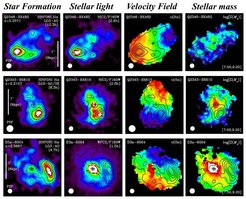
Remarkably, we found from SINS/zC-SINF that z ~ 2 disks are characterized by high intrinsic velocity dispersions of σ0 ~ 30–80 km/s and inferred gas to baryonic mass fractions of ~ 50% (Genzel et al. 2006, 2008; Förster Schreiber et al. 2006, 2009; Cresci et al. 2009; Newman et al. 2013). The velocity dispersions are five to ten times higher than in present-day disks, implying that young disk galaxies are dynamically hotter and geometrically thicker, plausibly as a consequence of the enhanced accretion and star formation rates at early cosmic epochs. In contrast to the rotation velocity vrot, the intrinsic dispersion σ0 shows little if any dependence on galaxy size, explaining the larger fraction of dispersion-dominated (vrot / σ0 < 1) objects among smaller galaxies. Large velocity dispersions have now also been observed in the molecular gas component of z ~ 1–2.5 disks as part of the PHIBSS/PHIBSS2 surveys – an important finding demonstrating that these properties are characteristic of the entire ISM of high-redshift SFGs, not just the ionized gas layer (Tacconi et al. 2013; Genzel et al. 2013). With our larger KMOS3D sample spanning the range 0.7 < z < 2.7, together with measurements from SINS/zC-SINF, and from the literature between z ~ 3 and z ~ 0, the evolution of the disk velocity dispersion is seen to increase with redshift as σ0 ∝ (1+z), in line with expectations for gas-rich disks and the observed evolution in molecular gas mass fractions as found in our PHIBSS/PHIBSS2 studies.
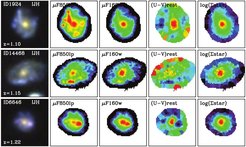
In the framework of marginally stable, turbulent gas-rich disks, the ubiquitous kpc-scale star-forming "clumps" seen in the Hα and CO emission of massive high-z disks result naturally from fragmentation of the gas disks into complexes whose size scales with gas fraction and σ0 (Genzel et al. 2008, 2011; Förster Schreiber et al. 2011b; Tacconi et al. 2013; Wuyts et al. 2013). Such kpc-scale clumps are also prominent in rest-UV stellar light, but become fairly inconspicuous at rest-optical wavelengths and nearly absent in the stellar mass distribution (Wuyts et al. 2012); clumps thus trace local peaks in star formation rather than in mass. These findings may indicate that clumps are rapidly destroyed by strong stellar feedback and tidal shear. Alternatively, if they survive disruption, clumps must then migrate toward the center of galaxies on rapid timescales of ≲ 100 Myr. Inward clump migration, along with efficient gas inflows triggered by violent disk instabilities, may contribute to the early buildup of massive bulges.
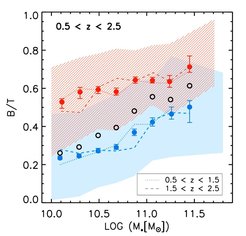
The z ~ 2 disks in our SINS/zC-SINF AO sample exhibit trends of increasing central dynamical mass fraction and stellar mass B/T ratio with galaxy mass and evolutionary stage, and of older clump ages at smaller galactocentric radii (Genzel et al. 2008, 2014; Förster Schreiber et al. 2011b; Tacchella et al. 2015a). More generally, while the stellar light and mass distribution of SFGs at z ~ 1–3 is on average disk-like, with median Sérsic index n ~ 1, our measurements of stellar structure from the CANDELS high-resolution imaging also reveal a trend of increasingly cuspy profiles along the main sequence, reaching n>2 and bulge to total mass ratios up to 50% in the most massive, log (M⁎/M☉) > 11 SFGs (Wuyts et al. 2011b; Lang et al. 2014). The weak correlation between the inferred halo-scale angular momentum parameter of ~ 360 SFGs, mostly from KMOS3D and SINS/zC-SINF, and the stellar density in their inner 1 kiloparsec provide evidence in support of bulge formation via internal dynamical processes in gas-rich disks, such as the recently proposed efficient "compaction" mechanism, rather than through a more gradual inside-out growth scenario (Burkert et al. 2016).
Powerful Outflows and Star Formation Quenching
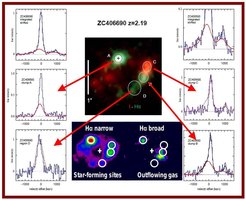
Our SINS/zC-SINF and KMOS3D observations have pinpointed the origin of the ubiquitous galactic-scale winds in high-z SFGs. Outflows with modest velocities (FWHM ~ 450 km/s) but substantial mass ejection rates comparable to the SFRs are detected in ionized gas across the disks and especially around intensely star-forming clumps, and are thus plausibly driven by star formation feedback (Genzel et al. 2011; Newman et al. 2012a,b). The left figure shows one of the SINS/zC-SINF galaxy where the telltale outflow signature of a broad, blueshifted emission component is clearly seen in and around bright star-forming clumps. This discovery pinned down the roots of the ubiquitous galactic-scale winds at high redshift so far only observed on > 10 kiloparsecs scales (e.g., Shapiro et al. 2009). The winds appear to set at a SFR surface density of ~ 1 M☉/yr/kiloparsec2, ten times higher than the breakout threshold in nearby starbursts and attributed to enhanced gas pressure in z ~ 2 disks. Outflow rates from clumps and from the galaxies reach up to several times their SFRs. Gas-rich clumps may be self-destroyed by such vigorous feedback before they migrate to the galaxy center, as seen in our numerical simulations (Genel et al. 2012).
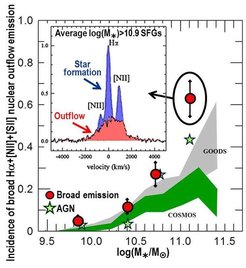
Most excitingly, we have discovered powerful high-velocity (FWHM ~ 1,000 to 2,000 km/s) ionized gas outflows in the centers of the most massive but otherwise normal SFGs, most likely driven by AGN activity. The frequency of these nuclear outflows raises sharply at log(M⁎/M☉) ~ 10.9, reaching 2/3 among the ~ 130 targets we investigated above this mass to date (right figure). These SFGs were selected based on mass and on their location around the main sequence of SFGs, rather than by the presence of an AGN. In fact, <50% of these galaxies are classified as hosting an AGN from classical X-ray, optical, IR, and radio indicators, suggesting the nuclear outflows have a higher duty cycle than the extrermely variable AGN activity. The typical high inferred mass outflow rates (dMout/dt > SFR) and momentum deposition rates (vout×dMout/dt ~ 20×L/c), together with the presence of massive bulges, and with evidence for suppressed star formation and gravitational quenching in the inner 2 to 3 kiloparsecs of half of the galaxies, make a compelling case that these nuclear winds play an important role in clearing the central regions of gas prior to quenching.
Nebular Gas Excitation and Metallicity
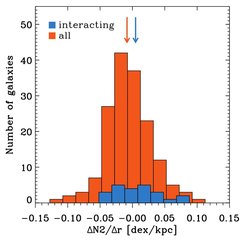
An analysis of Hα, [NII], [OIII], and Hβ line emission among our SINFONI+LUCI samples confirms enhanced global nebular excitation at z ~ 2 compared to typical z ~ 0 SFGs, implying higher ionization parameters and electron densities in the non-AGN galaxies (Newman et al. 2014). Shock excitation attributed to star-formation-driven outflows is detected around bright clumps in our best-case, high-S/N non-AGN disk (Newman et al. 2012a). The LUCI+SINS/zC-SINF+KMOS3D galaxies follow the previously reported mass-metallicity (M-Z) relations over 0.7 < z < 2.7, but suggest higher metallicities and/or more frequent AGN contamination at the high-mass end, partly reflecting the lesser bias against dustier and/or more evolved galaxies in our samples (Wuyts et al. 2014, 2016). At fixed stellar mass, galaxies with higher SFRs do not tend to be more metal-poor, challenging the proposed fundamental M∗-Z-SFR relation. Our measurements of [NII]/Hα radial profiles in 180 KMOS3D and 20 SINS/zC-SINF+AO SFGs, tripling existing samples at z ~ 1−3 in the literature, imply on average flat intrinsic gas-phase metallicity gradients even when accounting for beam smearing (Wuyts et al. 2016). Given that most of the galaxies show no sign of interaction/merging, these results suggest efficient metal mixing mediated by strong outflows, as predicted by cosmological simulations and observed in a majority of our sample.









